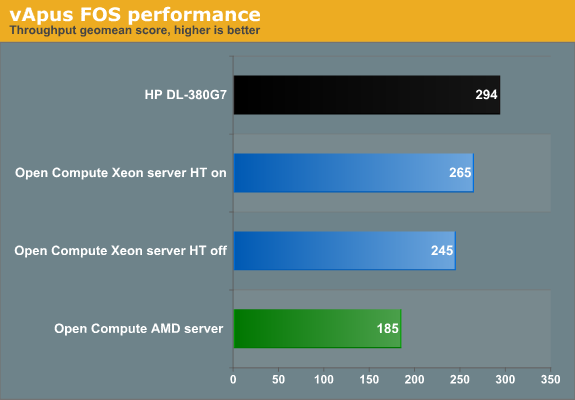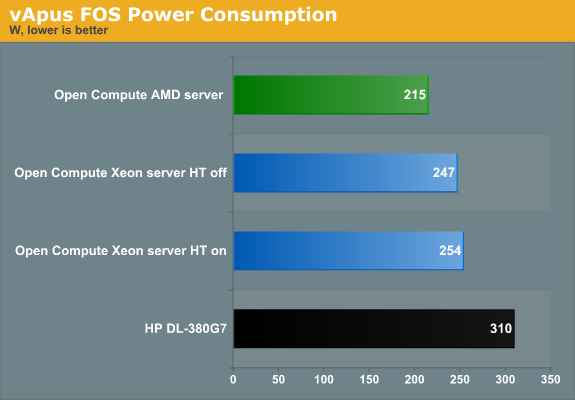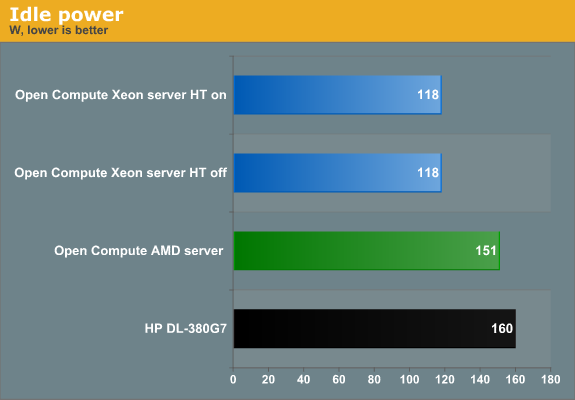Facebook's "Open Compute" Server tested
by Johan De Gelas on November 3, 2011 12:00 AM ESTvApus FOS results
In the first test, we use the vApus FOS test that pushes the servers to 90 - 100% CPU load. This performance test is not really important as these kind of server / application combinations are not supposed to run at these high CPU loads. Also remember that this is not an AMD versus Intel graph. The AMD based Open Compute server is used as a memcached server that typically hogs RAM space but does not stress the CPU; the Intel Open Compute Server is built to be a CPU intensive web application server. Thus, you should not compare them directly.
The real comparison is between the HP DL-380G7 and the Facebook Open Compute Xeon Server, which both use the same platform: the same CPUs, the same amount of RAM, and so on. The big question we want to answer is whether Facebook's server that is built specifically for low power use and cloud applications can offer a better performance/watt ratio than one of the best and most popular "general purpose" servers.

When requiring the highest performance levels, the HP DL380 G7 is about 11% faster than the Open Compute alternative. We suspect that the Open Compute server is configured to prefer certain lower power, lower performance ACPI settings. However, as this server is not meant to be an HPC server, this matters little. A web server or even virtualized server should not be run at 95-100% CPU load anyway. Let us take a look at the corresponding power consumption.

To deliver 11% higher performance, the HP server has to consume about 22% more power. The Open Compute servers deliver a higher performance/watt even at high performance levels. The advantage is small, but again these servers are not meant to operate at 95+ % CPU load.
We also checked the power consumption at idle.

The results are amazing: the Open Compute servers need only 74% of the power of the HP, saving a solid 42W when running ide. Also remember that the HP DL380 is already one of the best servers on the market from power consumption point of view.
Let us see what happens if we go for a real-world scenario.










67 Comments
View All Comments
harrkev - Thursday, November 3, 2011 - link
You should look again at the sine-wave plots. Power factor has more to do with the phase of the current and not so much how much like a sine-wave it looks like.As an example, a purely capacitive or purely inductive load will have a perfect sine wave current (but completely out of phase with the voltage), but have a power factor very close to zero...
So, those graphs do not really tell us much unless you actually crank the numbers to calculate the real power factor.
http://en.wikipedia.org/wiki/Power_factor#Non-line...
ezekiel68 - Thursday, November 3, 2011 - link
On page 2:"The next piece in the Facebook puzzle is that the Open Source tools are Memcached."
In fact, the tools are not memchached. Instead, software objects from the PHP/c++ stack, programmed by the engineers, are stored in Memcached. Side note - those in the know pronounce it "mem-cache-dee", emphasizing with the last syllable that it is a network daemon. (similar to how the DNS server "bind" is pronounced "bin-dee") So the next piece is Memcached, but the tools are not 'memcached'.
JohanAnandtech - Thursday, November 3, 2011 - link
That is something that went wrong in the final editing by Jarred. Sorry about that and I feel bad about dragging Jarred into this, but unfortunately that is what happened. As you can see further, "Facebook mostly uses memcached to alleviate database load", I was not under the impression that the "Open Source tools are Memcached. " :-)ezekiel68 - Thursday, November 3, 2011 - link
I was pretty sure it was a mistake and I only mentioned it to have the blemish removed - I've been following and admiring your technical writing since the the early 2000s. Please keep on bringing us great server architecture pieces. Don't worry about Jarred, he's fine too. We all make mistakes.Dug - Thursday, November 3, 2011 - link
I'm curious what the cost would be on the servers compared to something like the HP.Lucian Armasu - Thursday, November 3, 2011 - link
According to SemiAccurate, Facebook is considering Calxeda's recently announced ARM servers, too. It could be a lot more efficient to run something like Facebook on those types of servers.JohanAnandtech - Thursday, November 3, 2011 - link
I personally doubt that very much. The memcached servers are hardly CPU intensive, but a 32 bit ARM processor will not fit the bill. Even when ARM will get 64 bit, it is safe to say that x86 will offer much more DIMM slots. It remains to be seen how the ratio Watt/ RAM cache will be. Until 64 bit ARMs arrive with quite a few memory channels: no go IMHO.And the processing intensive parts of the facebook architecture are going to be very slow on the ARMs.
The funny thing about the ARM presentations is that they assume that virtualization does not exist in the x86 world. A 24 thread x86 CPU with 128 GB can maybe run 30-60 VMs on it, lowering the cost to something like 5-10W per VM. A 5W ARM server is probably not even capable of running one of those machines at a decent speed. You'll be faced with serious management overhead to deal with 30x more servers (or worse!), high response times (single thread performance take a huge dive!) just to save a bit on the power bill.
As a general rule: if the Atom based servers have not made it to the shortlist yet, they sure are not going to replace it by ARM based ones.
tspacie - Thursday, November 3, 2011 - link
The FaceBook servers take a higher line voltage for increased efficiency. What voltage was supplied to the HP server for these tests?JohanAnandtech - Thursday, November 3, 2011 - link
Both servers used 230V. I have added this to benchmark page (Thanks, good question). So in reality the Facebook server can consume slightly less.Alex_Haddock - Thursday, November 3, 2011 - link
TBH we'd position SL class servers for this kind of scenario rather than DL380G7 (which does have a DC power option btw) so not sure it is a relevant comparison. Though I understand using what is available to test.